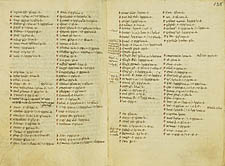Subject Indexing
![]()
The printed book encouraged indexing because the contents of each copy
of a given edition were largely fixed. In contrast, every manuscript of
a given work was unique: the pages of one manuscript did not correspond
precisely to those of another because they lacked the standardization
that mechanical reproduction imposed. Scribes generally did not even number
their pages. Consequently, finding information on a given subject required
skimming the entire manuscript. Frustration with this procedure is reflected
in this index to a collection of sermons, which presents subject headings
arranged in alphabetical order. The Roman numerals that follow refer to
the numbers of the sermons. The utility of such an index is obvious; it
enabled a preacher to locate treatments of his subject matter quickly.
Since only texts with stable numerical elements could be indexed, it was
not until page numbering became standard practice that indexes could become
a regular feature of books.
Obtained in 1897 for A. D. White.
![]()
Sermons with Index. Italy, late fourteenth or
early fifteenth century.
![]()

Copyright
© 2002 Division of Rare & Manuscript
Collections
2B Carl A. Kroch Library, Cornell University, Ithaca, NY, 14853
Phone Number: (607) 255-3530. Fax Number: (607) 255-9524
For
reference questions, send mail to:
rareref@cornell.edu
If you have questions or comments about the site, send mail to: webmaster.
